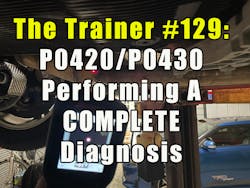The Trainer #129: P0420/P0430 – performing a COMPLETE diagnosis
The P0420/P0430 trouble codes are the #1 DTCs in the U.S. And the most common repair made is the replacement of the catalytic converter.
But all too often, this doesn’t keep the Check Engine light off.
When tackling these DTCs, the first step is understanding how converters fail. A common cause of converter failure is overheating, leading to damage to the converter substrate. Overheating, though, is typically a result of problems in the feed gasses entering the converter. These feed gasses must be maintained in a very narrow lambda range for the converter to work most efficiently. If not, the converter will overheat.
Another common cause is the poisoning of the converter. This occurs when the substrate becomes covered with a foreign substance – usually oil or coolant. If the substrate is coated, active conversion can’t take place.
Physical damage is also a cause of converter failure. Damage to the converter housing, cracks in the exhaust system allowing air into the converter, and broken welds are all examples of physical damage.
The second step in a successful repair is understanding how the ECM determines that the converter isn’t converting. The ECM monitors the oxygen sensors upstream and downstream of the converter and compares the switch ratio between the two. The upstream sensor, conventional or wideband, is expected to switch continuously from lean to rich while the downstream sensor should remain relatively stable in its output. The more the rear sensor activity mirrors the front, the higher the switch ratio will be.
The third step is to see if any conversion is taking place. This can be done with an IR temperature gun or thermal imager. Bring the vehicle up to full operating temperature. Using the thermal imager, measure the temperature at the weld ring on the inlet side of the converter. Next measure the temperature of the weld ring on the outlet side of the converter. The conversion process creates heat. If the outlet is 20 degrees or hotter than the inlet, the odds are pretty good that some conversion is taking place.
The fourth step is to further inspect the operation of the converter. There are several ways you can do this. If the vehicle uses conventional oxygen sensors, you can compare the switching activity using the scan tool in graph mode or, for even greater accuracy, the scope. If the front sensor is a wideband sensor, look for a data PID that will display the sensor’s current value, also in graph mode. This is what the ECM is looking at for the switch rate comparison.
Mode $06 is also a good place to look for information. Review the test results for the Catalyst Monitor, especially anything that indicates switch rate. Specifically, what we’re looking at is the test result compared to the minimum and or maximum test values allowed. Think of those values as goal posts. The closer the test result is to either value, the closer the test is to failing.
With some basic info already in hand, the fourth step is to check for any related Technical Service Bulletins. Many times, all that is needed is a reflash to turn the Check Engine light off. This is a good possibility if your earlier observations led you to believe that the cat is working even though the ECM says it's not.
Cleaning the converter using a slow drip fuel induction cleaner added through a central vacuum port may bring the converter back to life. Note the current Mode $06 test results before attempting to clean the converter. Then compare the new test results after the cleaning. If you note an improvement, then the DTCs may have been caused by converter poisoning. If that’s the case, the cause must be corrected or the problem will repeat.
Correcting the cause is also critical if the converter has failed as a result of overheating. Signs of overheating include a converter housing that has a blueish bronze discoloration, melted or broken substrate. Melted substrate may be noted using the thermal imager. Any cold spots in the middle of the housing seen when performing the temperature tests may indicate a melted section of the substrate. This can be further confirmed by removing the converter and looking through it. Melted substrate rarely occurs first at the inlet or outlet but will prevent light from passing through it.
Broken substrate can often be detected during a test drive by the rattling noise it makes. You can also use a rubber mallet to gently tap on the converter housing and listen for the rattle.
Common causes of overheating are engine misfires or improper fueling – system lean or system rich DTCs. Failure to correct these conditions prior to converter replacement will result in accelerated damage to the new converter – and a comeback.
Converters rarely fail due to age alone. Instead, it’s a symptom of another problem. Unless you correct the cause, the P0420 and P0430 you’re repairing will be back!
For more information on the Autel tools I used in today’s video, visit www. Autel.com!About the Author
Pete Meier
Former Creative Director, Technical | Vehicle Repair Group
Pete Meier is the former creative director, technical, for the Vehicle Repair Group with Endeavor Business Media. He is an ASE certified Master Technician with over 35 years of practical experience as a technician and educator, covering a wide variety of makes and models. He began writing for Motor Age as a contributor in 2006 and joined the magazine full-time as technical editor in 2010. Pete grew the Motor Age YouTube channel to more than 100,000 subscribers by delivering essential training videos for technicians at all levels.
Connect with Pete on LinkedIn.


